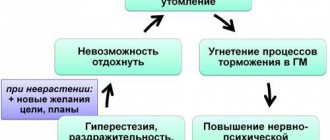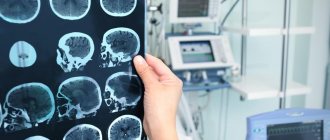In the modern world, with its accelerated pace of life, there are more and more people suffering from various neurotic disorders. Neuroses are practically the scourge of the twenty-first century, and, unfortunately, they become “younger” every year. Increasingly, workload at school and extracurricular activities, chronic fatigue, stress and many other factors contribute to the development of neurotic disorders in children and adolescents. One of these diseases is obsessive movement neurosis.
Obsessive movements or obsessive-compulsive disorder in children - what is it?
Obsessive movement syndrome is part of a whole group of neuroses united by the concept of obsessive-compulsive personality disorder.
Obsessive-compulsive disorder is a mental disorder characterized by obsession with obsessive states (thoughts, phobias, memories, doubts, actions). The patient is constantly under the yoke of anxious thoughts and fears (obsessions). For example, a child is terrified of contracting some terrible fatal disease, or it seems to him that with his thoughts he can harm someone, or he cannot calmly leave the house, because he believes that then something will definitely happen. Anxiety grows, prevails, and then, in order to somehow relieve itself, the patient performs some actions (compulsions) that, in his opinion, should prevent this or that event: constantly washes his hands; spits over his left shoulder and knocks on wood with every “bad thought”; Before leaving the house, he places things on the table in a certain order. Obsessions are characterized by their cyclical nature and involuntariness (they have a character that is alien to the patient; he does not want them to appear and fights them). The struggle (compulsion) can be direct (as in the case of washing hands), that is, directed directly against fear (I’m afraid of getting infected - wash my hands, kill germs) and indirect, not related to fear in its meaning (count to ten before leaving the house and turn on one leg counterclockwise). Such compulsions are called rituals.
Obsessive movement syndrome in children also manifests itself in involuntary, frequently repeated actions. It could be:
- grimacing;
- smacking, coughing, clicking fingers or knuckles;
- twirling hair on a finger;
- cheek twitching;
- chewing pencils, pens, nails;
- thumb sucking;
- hair pulling;
- scratching the skin;
- waving your arms;
- shoulder twitching and so on.
It is difficult to list all possible motor obsessions; they are quite variable and individual. Some of them can be confused with nervous tics, but unlike tics, which are caused by automatic muscle contraction and cannot be controlled, obsessive movements can be suppressed (though not easily) through willpower. In addition, as mentioned above, there are so-called protective rituals, which from the outside look like strange habits. For example, a child goes around all obstacles from a certain side, puts notebooks in a backpack only with his left hand, before going to bed, jumps on one leg a certain number of times, etc. The nature of such “rites” can be very complex.
Also, children suffering from obsessive-compulsive disorder are characterized by a pathological desire for order and cleanliness (meaningless moving objects from place to place, frequent hand washing).
Obsessive movements (actions) are caused by psycho-emotional discomfort, they are aimed at calming anxiety.
Age-related aspects of obsessive-compulsive disorder
Obsessive disorders in children
One of the first to describe obsessive states in children was P. Janet (1903), presenting the typical symptoms of this disorder in a 5-year-old child and noting that with obsessions in children, there is a certain feature of cognitive processes that seems to “paralyze” those functional abilities of the brain , which prevent the occurrence of obsessions.
L. Kanner in 1935, in Germany, made a report in which he outlined the classic symptoms of obsessive-compulsive disorder and formulated its main diagnostic criteria. He also proposed a psychological theory of the origin of obsessive states, emphasizing that the latter are a consequence or “overdose of the perfectionism of parents” who strive to raise “correct children” and protect them from the imagined dangers of life. L. Kanner about children resisting obsessions, trying to discover and explain the reason for their appearance, and doing something as best and more perfectly as possible. L. Berman (1942) described in detail four cases of obsessive-compulsive disorder in children, while discovering clinical similarities in the content of obsessive states in children and adults, in particular regarding sexual perversions, fear of death of parents and compulsive counting. L. Despert published an article in 1955 on the differential diagnosis of obsessive-compulsive neurosis and schizophrenia. Among 400 patients who noted signs of obsessive states, she identified obsessive-compulsive neurosis in 70 cases. The author found that there were 3 times more boys with obsessive disorders than girls. In addition, the study proved the effectiveness of psychotherapy in promoting a faster reduction of anxiety and depression.
S. Freud (1909-1913) repeatedly described childhood “obsessive neurosis”, adhering to his theory of “pregenital sexual organization”; he noted the important role in the genesis of obsessive states in children “constitutional” influence of heredity and stress. A. Freud (1965), examining the clinical manifestations of obsessive states, expressed the point of view that the symptoms of this pathology often appear in isolation, and obsessions associated with the ritual of “going to bed” and counting compulsion are found in children characterized by impulsive behavior.
A. Kaufman (1979) revealed cognitive rigidity and a relatively weak ability to integrate external stimuli in children suffering from obsessive-compulsive disorder.
For children aged 4 to 10 years, repeated variations or stereotypes of behavior are quite typical, for example, such as a periodic need to count, small hand movements, collecting and collecting. Sometimes children often touch the same things, walk around cracks in the asphalt, step over a step, step on tile squares in a certain sequence.
All this, of course, cannot be called rituals, since these actions are not intended to protect against any danger, are relatively short-term, weakly expressed and are not accompanied by strong affect or anxiety.
Some tendency or predisposition to obsessive states in children can be seen in obsessive repetitions of the same words or actions, doubts about the correctness or incorrectness of one’s own actions, repeated questions, a magical idea of the world around him, fear of punishment and a tendency towards antitheses, rituals and games characterized by complex ceremonies and adherence to all kinds of taboos.
In the absence of anxious-suspicious and fearful character traits, children relatively easily overcome all these obsessions; on the contrary, with self-doubt, increased anxiety and vulnerability, easily formed feelings of guilt and remorse, more persistent obsessive states develop. For the most part, anxious and suspicious character traits are partly inherited, partly brought up under conditions of overprotection from an anxious mother or grandmother who adheres to strict rules.
Obsessive states in children are usually expressed either in the form of obsessive phobias or rituals, but most often mixed states occur.
Childhood obsessions
- Fear of pollution, infection with infectious agents - 40%
- Thoughts and images related to an accident (fire, bandit attack, sudden death or illness) - 25%
- Striving for symmetry and order - 15%
- Religious thoughts - 15%
- Thoughts about problems related to body secretions (urine, stool, saliva) - 10%
- Thoughts about numbers - 10%
- Thoughts and images associated with aggression - 5%
- Thoughts, images and desires associated with sexual perversion - 5%
- Fear of harming yourself or others - 5%
- Intrusive sounds, words and music - 5%
Childhood compulsions
- Cleansing rituals: hand washing, bathing, brushing teeth, etc. - 85%
- Rituals for the beginning and end of an action (“rituals of exit and entry”): opening and closing a door, going over a step and back - 50%
- Testing rituals: door closed or open, lights or gas turned off, homework done correctly, notes in notebooks, etc. - 45%
- Rituals associated with writing, movement and speech - 25%
- Rituals that protect against infection or pollution - 20%
- Touching objects - 20%
- Rituals that protect against harm to yourself or others - 15%
- Placing objects in a certain order, symmetrically with respect to each other - 15%
- Collecting, collecting - 10%
- Rituals for cleansing objects: washing dishes, wiping dust, etc. - 5%
Relatively rarely, obsessive states in children begin to manifest themselves as obsessive counting.
In preschool children, phobias occur less frequently than obsessive actions (repetition of movements, shouting of words, etc.), since it is difficult for the child to realize the component of alienation of experiences to one’s own “I” that is characteristic of an obsessive state.
With neurotic phobias, chronobiological and meaningful connections with a stressful situation are usually identified. Children's phobias, in general, in most cases are obsessive, and not overvalued. Defensive actions are, as it were, “fused” with fears and form a single whole with them. In schizotypal disorder, on the contrary, in most cases, phobias are of an overvalued nature and are characterized by pointlessness, rapid generalization, “fouling” with ideational obsessions, close in their manifestations to mental automatisms and rituals (Gordeeva E.A., Kazantseva E.L., 2010) .
Pathological fears in preschoolers are characterized by poor intellectual content, lack of criticism towards them, and are limited to specific and hypochondriacal phobias and panic disorders. With increasing age, the complexity, polymorphism and degree of completeness of phobic disorders increases. A clinically more defined phobic syndrome is formed starting from primary school age: social phobias and elements of criticism of pathological fears appear.
Approximately one third of adult patients suffering from obsessive-compulsive disorder note that their first obsessions first appeared in childhood (Black A., 1974).
In the puberty period, nosophobia and social phobias dominate. Agoraphobia can also develop in adolescence (Kazantseva E.L., 2010).
Phobias in adolescents have a certain specificity. Isolated phobias of abstract content (depth, height, darkness) are archaic in nature, hereditarily determined, perceived by the patient as part of his essence and do not lead to maladaptation requiring therapeutic correction. Similar phobias include phobias of natural disasters and man-made disasters that do not affect the teenager. These phobias have a sociogenic origin, are perceived as abstract, do not correlate with mental illness or hereditary predisposition, are variable in plot and are rarely accompanied by avoidant behavior. Usually they also do not require special therapeutic intervention. Phobias that form according to the mechanism of reactive formation are determined by a stressful situation that is significant for a teenager and a personal structure with a pronounced sensitive radical, impressionability, and self-doubt.
Such phobias are nosologically specific, tend to have a prolonged course and are often comorbid with affective spectrum disorders. Treatment of these phobias is similar to the treatment of protracted reactive and neurotic disorders. Phobias in the structure of schizotypal disorder usually represent a complex syndrome, with a tendency to transformation, reflecting the progression of a sluggish schizophrenic process. They rarely determine the picture of acute episodes of schizophrenia (Mazaeva N.A., Golovina A.G., 2010).
The results of epidemiological studies indicate that obsessive-compulsive disorder is registered in 1 to 4% of children in the general population (Flament M., Chabane N., 2000), with an approximately equal ratio between boys and girls.
In boys, obsessive states manifest themselves more clearly than in girls; in the former, obsessions are also more often than in the latter accompanied by various tics (Leonard H., et.al., 1992).
In children of early and preschool age, one of the most common obsessive actions is thumb sucking; it is often compensatory in nature, relieving feelings of anxiety. In stressful situations or before falling asleep, a child, who is often brought up in conditions of deprivation, performs this obsessive action to calm down.
Obsessive disorders in children usually arise in late childhood, but, as noted earlier, they can appear earlier, for example, at the age of 2-5 years. In part, the time of occurrence of obsessive states depends not only on the age of the child, but also on his intelligence, the achievement of a certain level of self-awareness necessary for the special attitude of the developing personality to obsessive phenomena. Often, in the process of developing obsessive states in children, two stages can be traced, the first manifesting itself as individual neurotic reactions and the second, which is already a fairly persistent neurotic disorder.
The most common type of rituals in children is repeated hand washing, the most common obsessions are the fear of contamination or infection with any disease from friends and relatives, followed by the desire for order, manifestations of aggression and the desire to place objects symmetrically (Franklin M. et. al. 1998) . Often the key stimuli or triggers for fear of pollution are dirty objects.
One of the common obsessive phobias of younger children is the fear of small sharp objects (needles, knitting needles, etc.).
Cases of claustrophobia have also been reported in children, as well as obsessions regarding the ritual of dressing and eating.
In children 5-7 years old, simple phobias usually concern the fear of the dark, school, death of animals, insects, and sharp objects.
In almost 90% of cases, these phobias occur for a relatively short period of time, go away on their own and do not require therapy (Last C.et.al., 1997).
In most cases, children usually hide their rituals from their parents. However, when doing homework and homework assignments, it is discovered that children work unproductively and spend a lot of time on unnecessary rituals, for example, carefully writing out letters or numbers, repeating the same phrases, staying up for a long time, carefully arranging things in a certain order, repeat the same movements when walking, sigh in the same way, and get home from school unreasonably slowly.
In children, we are more likely to encounter rituals (mostly tactile) than obsessive thoughts or drives. This is probably due to the fact that children have an insufficiently developed cognitive sphere and they cannot always correctly interpret or accurately express their experiences in words. It is fair to assume that if this quality occurs in some adults, then in this case we can more likely expect the emergence of rituals.
According to Yu.F. Antropova (2010) obsessive ideas in childhood in isolated form are relatively rare and usually appear in an atypical rudimentary form without a sufficiently expressed experience of their alienness and without full criticism. Rudimentary ideation obsessions in children of senior preschool age include the desire to repeatedly ask the same type of questions that have no cognitive purpose or are even meaningless: “Why is the paper white?”, “Why is water dripping?” And so on. " At the same time, children do not even wait for an answer, stereotypically repeating the same question. V.M. Bashina (1980) encountered these obsessions in childhood schizophrenia in children 3-6 years old, and often rudimentary obsessive fears were combined with repeated aimless movements - rudimentary motor obsessions. Such fears were considered as rudiments of obsessive phenomena, since with them there was no child’s experience of their alienness and the desire to overcome them.
V.V. Kovalev (1985) noted monotonous questions in borderline states, believing that these obsessions occupy an intermediate place between rudimentary motor (speech motor) and ideational obsessions.
Obsessive actions of children most often manifest themselves in isolated elementary movements and actions (wrinkling the forehead, licking lips, etc.). They can be more complex, representing a sequence of several elementary obsessive actions or multi-component complex rituals of an abstract or incantatory nature, aimed at combating phobias or doubts.
In the etiology of obsessive-compulsive disorders in children, the genetic factor plays a greater role than in adult patients. At the same time, frequent cases of registration of obsessions in the same family may indicate a kind of training by one family member of another.
In the genesis of obsessive-compulsive states, the role of an infectious disease is seen, primarily streptococcal (beta-hemolytic streptococcus) infection of the nasopharynx.
Typically, patients suffering from streptococcal infection begin to demonstrate obsessive states 3-4 years earlier than other children suffering from obsessions, for example, arising from organic brain damage as a result of an unsuccessful birth. In addition, the role of an infectious factor is indicated by the exacerbation of symptoms in the evening and the clearly recurrent nature of the course of the disease (Swedo S., et. al., 1989). The doctor should also take into account the fact that with obsessions arising as a result of a neuroinfectious process, there is pronounced emotional lability, a pronounced anxiety reaction in case of separation from parents, motor hyperactivity, impulsivity and absent-mindedness in time, correlated with an exacerbation of streptococcal infection (Swedo S., et al. al., 1998).
In the etiology of neurotic disorders, including obsessive-compulsive disorders, in school-age children and adolescents, a large role is played by chronic traumatic situations associated with a conflict between drives and a sense of duty; emotional stress caused by increased responsibility, often demands on the child from the parents. In such children, long before the onset of obsessive states, there is excessive fearfulness of everything new, be it moving from one place to another or meeting strangers. In preschool age, they are characterized by suspiciousness, a tendency to come up with various prohibitions against themselves, and a belief in magic. During the game, they come up with new rules for themselves, somewhat reminiscent of rituals, and strive to maintain strict consistency when performing everyday actions, for example, dressing or eating.
In almost 90% of cases, a child suffering from obsessive-compulsive disorder can have problems related to school, the family situation, or difficulties communicating with peers (Piacentini J. et. Al., 2003).
In the pathogenesis of obsessions in children, the most important place is occupied by changes in the serotonergic system, dysfunction in the basal ganglia and autoimmune disorders. Examples include obsessive-compulsive disorder in Tourette's syndrome or Sydenham's chorea. In the latter case, along with the infectious pathogen - group A beta-hemolytic streptococcus, autoimmune changes can also be observed.
In children of preschool and primary school age, especially with weak intellect, obsessions can arise under the influence of acute mental trauma, accompanied by fear. “Fear neurosis” (Sukhareva G.E., 1959), initially manifesting itself as overvalued formations, later acquires the character of obsessive fears (Skanavi E.E., 1962).
Obsessive actions have an ambiguous pathogenesis at different stages of the disease. In schizophrenia, they initially have the protective nature of rituals, and later, when the emotional component disappears, they turn into motor and speech automatisms (Sukhareva G.E., 1974).
Children with obsessions try to avoid homework and household duties, and the more intense the obsessions manifest themselves, the more family problems they have, regardless of the child’s gender and age.
Obsessive states in children are often combined with depressive and anxiety disorders. Adolescents, usually under the influence of strong experiences, may develop an obsessive urge to commit suicide.
Also relatively often, apparently, in at least a third of cases, obsessions are accompanied by various tics .
Tics, like obsessive actions, manifest themselves especially clearly in children against the background of emotional stress, which seems to be relieved by a motor discharge or intensifies when the obsessive movement is delayed.
The course of the neurotic variant of obsessive states is different, from a rapid increase in symptoms to slowly progressing, wave-like light intervals can be replaced by periods of exacerbation of the disease
At first, children may hide their obsessions, trying to fight them outside the home, but then they actively involve their parents in participating and performing rituals, together with one of the parents, usually the mother, delving into the possible causes of obsessive states, often asking them to console or support them in the fight against them.
Typically, young children may not have a critical attitude towards obsessive states. The emotional component of experiences (tears, screams) and psychomotor agitation come to the fore here.
It has been noted that, probably due to the insufficient development of critical abilities, a characteristic sign of obsessions for children is a feeling of relief that occurs after performing all kinds of rituals (Bulakhova L.A., Sagan O.M., 1985).
Neuropsychological studies of children suffering from obsessive-compulsive disorder have shown a wide range of results and the absence of a clear correlation between the severity of obsessive states and neuropsychological disorders (Bechar D., et. Al., 1984).
In a psycholinguistic study by C. Ludlow et., el. (1989) showed that tests of short-term memory, when analyzing indicators of verbal memory by presenting words visually or auditorily, do not reveal deviations from normative indicators, however, when presented with isolated visual stimuli, children suffering from obsessive-compulsive disorder begin to experience difficulties in their memorization.
Adolescents are dominated by phobias associated with the consciousness of their physical self, obsessive fears of illness or death (from suffocation or cardiac arrest), fear of choking while eating, and fear of blushing. Fear for one’s own health is often transferred to loved ones and appears in the form of fear for the health of parents (Kovalev V.V., 1979).
Blasphemous and blasphemous thoughts that contradict the moral principles of a teenager can arise in cases where upbringing is quite demanding and is carried out not by the teenager’s parents, but by representatives of the older generation.
Teenagers who stutter may develop an obsessive fear of speaking.
E. Kraepelin (1915) once described the “expectation neurosis” that occurs in adolescents, manifesting itself as anxious anticipation and fear of failure when performing any habitual action, as well as violation of the latter when attempting to perform it (Svyadoshch A.M., 1971 ). V.V. Kovalev (1979) refers to “expectation neurosis” as the fear of oral answers in class that arises in a child who is well prepared for the lesson. According to the author, the phenomena of expectation neurosis are often associated as secondary disorders with other neurotic disorders, for example, neurotic stuttering and enuresis, neurotic insomnia, which aggravates primary neurotic disorders.
The content of intrusive thoughts may change as the child gets older. In adolescence, obsessive states occur whose content is sexual or religious in nature.
Obsessive states in children can be recorded both in the structure of obsessive-compulsive disorder and in other anxiety spectrum disorders (separation anxiety, social phobia, panic disorder, generalized anxiety disorder) and depression.
In general, obsessive states not related to obsessive-compulsive disorder are recorded in almost a third of childhood patients.
Monotonous, stereotypical movements are observed in cases of mental retardation, autism, tics; obsessions occur in eating disorders, obsessive-compulsive (anancastic) personality disorder. Note that in obsessive-compulsive disorder, unlike other disorders, rituals are usually well structured and organized, combined with obsessions and ego-dystonia.
Causes of obsessive movements
Shy, fearful, anxious-suspicious, overly impressionable, insecure children are predisposed to obsessive movements syndrome. The following factors can cause the development of neurosis:
- stress;
- chronic fatigue;
- psychological trauma (parental conflicts, dysfunctional family, loss of a loved one or pet, moving to a new place of residence, changing kindergarten or school, etc.);
- the appearance of another child in the family;
- dictatorial upbringing or, conversely, excessive permissiveness;
- excessive demands from parents and the inability to meet them;
- strict religious education;
- heredity;
- some diseases (tuberculosis, mononucleosis, viral hepatitis, measles)
- organic brain lesions;
- traumatic brain injury.
Diagnosis of obsessive movement syndrome in children is based on complaints from parents and observation of the patient. To make an accurate diagnosis, it is necessary to undergo a neurological, psychiatric examination, as well as psychological testing.
Mental factors
Also, chronic traumatic situations associated with:
- conflict between drives and sense of duty;
- emotional stress due to increased responsibility;
- requirements for the child from the parents.
These children, even before the appearance of obsessive states, show excessive fearfulness of everything new (moving from one place to another, meeting strangers). In preschool age, they are characterized by suspiciousness, a tendency to come up with various prohibitions against themselves, and a belief in magic. During games, they like to come up with new rules, similar to rituals, and are also characterized by strict consistency when performing everyday actions, for example, dressing or eating.
In almost 90% of cases, a schoolchild suffering from obsessive-compulsive disorder has problems in school, family relationships, and difficulties communicating with peers.
Treatment of obsessive movement syndrome in a child
If you ignore “strange or bad habits” and do nothing, the quality of life of a child with obsessive movement disorder worsens. He can physically harm himself: scratch his hands until they bleed, tear out a clump of hair, etc. In addition, sooner or later moral exhaustion may set in, because living in constant anxiety and fear is very difficult for an adult, let alone a fragile child’s psyche. This state of affairs is fraught with nervous breakdowns, depression, problems with social adaptation, and isolation. Often a child becomes a hostage to his own rituals. Over time, they can grow, making life simply unbearable.
The difficulty of treating obsessive movement syndrome in children is that at an early age they are not able to adequately assess their condition. That is, an adult with obsessive-compulsive disorder in 80% of cases realizes the irrationality of his behavior, the meaninglessness and uselessness of his own rituals, understands that something is wrong with him, and sooner or later he goes to a specialist. The child cannot understand and analyze what is happening to him.
If you notice that your child often and involuntarily makes any movements (actions) or has strange habits, you need to carefully observe him and try to independently identify the reasons for such behavior. Very often, the cause of obsessive movement syndrome in children is parental conflicts. A child suffering from neurosis subconsciously tries to attract the attention of others to the problem he has. The most important thing is to identify the traumatic factor and eliminate it. First, you need to improve the psychological climate in the family, try to minimize conflict situations and provide the child with calm, comfortable living conditions. It is very important not to scold for obsessive movements, to remember that this is not self-indulgence, not a whim or a protest. This is a mental disorder, and the child needs help. In cases where parents are unable to find out on their own what is causing the child’s obsessive movements, they should immediately contact a medical or child psychologist.
To eliminate the syndrome of obsessive movements in children, psychologists at our Center use methods of play therapy, sand therapy, fairy tale therapy, and art therapy. In addition, parents must be consulted on creating a psychologically comfortable environment for the child in the family and, if necessary, correcting the parenting style (if these factors formed the basis of childhood neurosis). This approach helps to quickly relieve increased anxiety, neutralize the consequences of psychological trauma (if any), teach the child to cope with stress in a more constructive way, and increase adaptive resources. When receiving timely support from a specialist, obsessive movements syndrome is relieved in a short time and goes away without a trace.
Make an appointment with a child psychologist by phone or leave a request on the website.
Where to start treating neuroses?
Go to specialists who comprehensively examine the child’s body. By the way, from the above it follows that children with chronic diseases (including those suffering from allergic reactions) are prone to neuroses. Early diagnosis of symptoms and prevention, observation by somnologists, neurologists and psychologists will help to adapt to society, avoid neurotic manifestations, and strengthen the nervous system.
Such comprehensive examinations are carried out at the LINGUABONA clinic. Experts say that by starting to solve the problem at an early stage, you can achieve excellent results. Having understood the grain of the problem, they begin to select methods of treatment, rehabilitation, and select the necessary medications.
Pathogenesis at different stages of OCD
Obsessive actions have an ambiguous pathogenesis at different stages of the disease.
For example, in schizophrenia: first the protective nature of rituals, then (with the disappearance of the emotional component) - motor and speech automatisms. Children with obsessions try to avoid homework and household responsibilities. Obsessive states in children are often combined with depressive and anxiety disorders. For example, adolescents may develop an obsessive urge to commit suicide. Also relatively often, apparently in at least a third of cases, obsessions are accompanied by various tics.
Monotonous, stereotypical movements are observed in cases of mental retardation, autism, tics; obsessions occur in eating disorders.
What is obsessional neurosis, and does it need to be treated?
The main goal of treatment is to maximize the patient’s quality of life. If a disease interferes with life, then it definitely needs to be treated. Does obsessional neurosis interfere with normal life? To understand this, you need to find out what is commonly understood by this term.
Obsession is the appearance in a person of thoughts or actions that are perceived by him as something alien. A person cannot get rid of them: obsessions force him to perform certain actions, thereby becoming the cause of debilitating mental discomfort.






